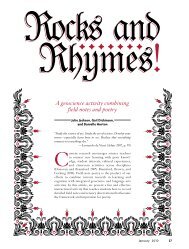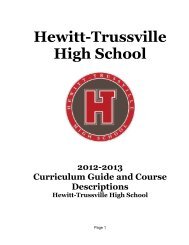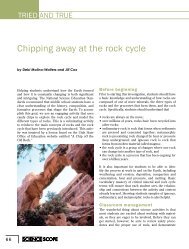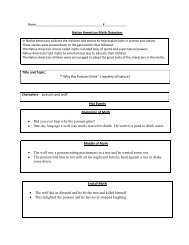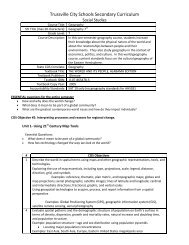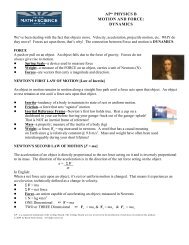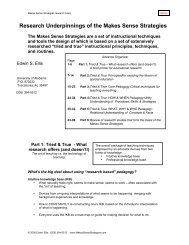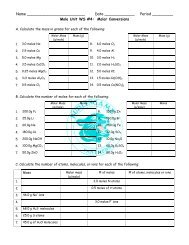WhatBelongsin Your 15-Bean Soup? - NSTA Learning Center
WhatBelongsin Your 15-Bean Soup? - NSTA Learning Center
WhatBelongsin Your 15-Bean Soup? - NSTA Learning Center
You also want an ePaper? Increase the reach of your titles
YUMPU automatically turns print PDFs into web optimized ePapers that Google loves.
○ ○ ○ ○ ○ ○ ○ ○ ○ ○ ○ ○ ○ ○ ○ ○ ○ ○ ○ ○ ○ ○ ○ ○ ○ ○ ○ ○ ○ ○ ○ ○ ○ ○ ○ ○ ○ ○ ○ ○ ○ ○ ○ ○ ○ ○ ○<br />
T E A C H I N G S T R A T E G I E S<br />
FIGURE 4<br />
FIGURE 5<br />
Rubric for evaluating taxonomic keys<br />
Able to identify items using the key<br />
Key moves from general to specific<br />
Couplets are indented or there is space between couplets<br />
Quantitative, consistent measurements, not small, large<br />
Precede with noun, followed by verb<br />
Begin choices with same character<br />
Begin couplet with different words<br />
Couplets appropriate in length<br />
Appropriate number of couplets<br />
Use of appropriate vocabulary<br />
Example of a key constructed<br />
by students using communities<br />
of paper fasteners<br />
Comments on the key resulted from peer evaluation by<br />
other student groups.<br />
to enclose related groups—for example,<br />
one loop of yarn could be used to enclose<br />
each “species group,” with a second, larger<br />
Yes No loop enclosing all species included in a<br />
single genus. Once students have sorted<br />
and ranked their groups, they should develop<br />
a classification scheme that reflects<br />
the relative degree of relationship among<br />
the objects.<br />
Once student groups have sorted<br />
their paper fasteners, ranked them, and<br />
developed a classification system, then<br />
they can write a dichotomous key that<br />
would allow other people to identify species<br />
in their paper fastener community.<br />
Evaluation of the keys may be done by<br />
the teacher using a rubric such as that<br />
shown in Figure 4. Alternatively, students<br />
can exchange dichotomous keys and utilize peer evaluation<br />
in a review and revision cycle prior to evaluation by<br />
the instructor. Figure 5 shows peer review comments from<br />
such a review and revision cycle, and indicates an extension<br />
of this classroom activity into standard taxonomic names<br />
assigned to the various paper fasteners.<br />
Conclusion<br />
The application of the <strong>Learning</strong> Cycle process to taxonomic<br />
principles, hierarchical classification, and construction of<br />
keys presents the components of classification that include<br />
sorting (grouping) and ranking as separate stages in classification.<br />
In addition, it separates production and use of keys<br />
from the classification process and presents it as a useful product<br />
of classification. Students frequently use keys to identify<br />
trees, insects, wildflowers, minerals, or rocks. Understanding<br />
concepts behind the classification process and production<br />
of taxonomic keys will enable the students to select<br />
appropriate keys for their region. A suggested extension is<br />
for the student to find a key from a source such as the<br />
Internet, libraries, bookstores, or state agencies to share with<br />
other students in the class. ■<br />
able from any office supply source. Students are instructed to<br />
sort their paper fasteners into groups equivalent to species,<br />
then rank groups into higher taxonomic categories (genus,<br />
family, etc.). To aid in ranking, they may use yarn loops again<br />
References<br />
Barrett, K., et al. 1992. GEMS: Investigating artifacts. Berkeley, CA:<br />
Lawrence Hall of Science, University of California at Berkeley.<br />
Beisenherz, P. and M. Dantonio. 1996. Using the learning cycle to<br />
teach physical science. Portsmouth, N.H.: Heinemann.<br />
Berlin, B., D. E. Breedlove, and P. H. Raven. 1973. General principles<br />
of classification and nomenclature in folk biology. American<br />
Anthropologist 75: 214–42.<br />
National Research Council (NRC). 1996. National Science Education<br />
Standards. Washington, D.C.: National Academy Press.<br />
Stuessy, T. F. 1990. Plant taxonomy. New York, N.Y.: Columbia<br />
University Press.<br />
Nov/Dec 2004<br />
science scope<br />
27



